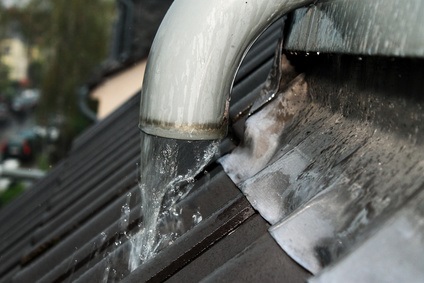
The top priority should be to seal as few areas as possible and thus allow natural seepage.
Rainwater flows to a large extent via streams and lakes to the sea and seeps into the subsoil and is the part of the natural water cycle that contributes significantly to the recharge of groundwater.
As a result of increasing building development and the sealing of surfaces, rainwater only partially enters the water cycle naturally; it collects on roofs and paved surfaces such as courtyards, parking lots or roads and no longer seeps away.
This rainwater is often drained into the sewer system. Problems occur during heavy rainfall and snowmelt; the sewer system and rainwater retention basins can only absorb the water masses to a limited extent. Permission to discharge into the sewer system is granted by Wolfsburger Entwässerungsbetriebe (WEB).
For ecological and economic reasons, this form of drainage is no longer up to date, as rainwater in combined sewer systems, like wastewater, has to be treated at great expense in the sewage treatment plant or, in separate sewer systems, is fed directly into surface waters, which are subject to enormous fluctuations in volume.
A sensible alternative to this can be to use rainwater in the household or to infiltrate it. As wastewater charges are calculated separately for rainwater and wastewater, this can also reduce the costs for wastewater in individual cases.
Rainwater can be used for garden irrigation from a cistern. A second water circuit in the house, e.g. for laundry and/or toilet flushing with rainwater, is permissible, but is not recommended by the health department for hygienic reasons.
A second, calibrated water meter must be installed with regard to the calculation of wastewater fees.
Further information and the application form for the registration of a garden water meter, can be found on our page on the property tax under the item "wastewater fees".
Information on the installation of a garden water meter can also be found on the page of the Wolfsburger Entwässerungsbetriebe (WEB).
In any case, a drinking water connection must be available, because a constant water supply via the cistern is not guaranteed, especially during seasons with less precipitation. In addition, complex filter technology is required.
Another sensible form of precipitation water drainage is infiltration on one's own property.
Prerequisite:
- no significant adverse effects on the water balance and no impairment of the groundwater
- permeable subsoil (kf-value)
- Sufficient absorption capacity of the subsoil (composition, thickness, groundwater interval)
- Ensure specifications for hazard-free infiltration. Harmless infiltration must be possible. Waterlogging or moisture damage to one's own or a neighbor's house can sometimes be very difficult and costly to eliminate. It is therefore essential to consult an expert before deciding on infiltration.
Taking the above criteria into account, a distinction is made between different types of decentralized infiltration:
- Surface infiltration (rainwater infiltrates essentially on the surface on which the precipitation also occurs).
- Swale infiltration
- Rigolen and pipe-rigolen infiltration
The infiltration of rainwater from roofs (except uncoated roofing with copper, zinc and lead) and yard areas on the respective property via the revitalized soil zone does not require a permit.
However, infiltration of rainwater is not always possible without prior purification, as contamination and pollutant loads may occur as a result of wash-off from roads, parking lots and surfaces used by commercial operations, for example.
If infiltration is to take place via technical facilities (infiltration trenches or similar), a permit under water law must be applied for.
In water protection areas and the Hoffmannquelle healing spring protection area in Fallersleben, precipitation water may only be infiltrated with official permission.